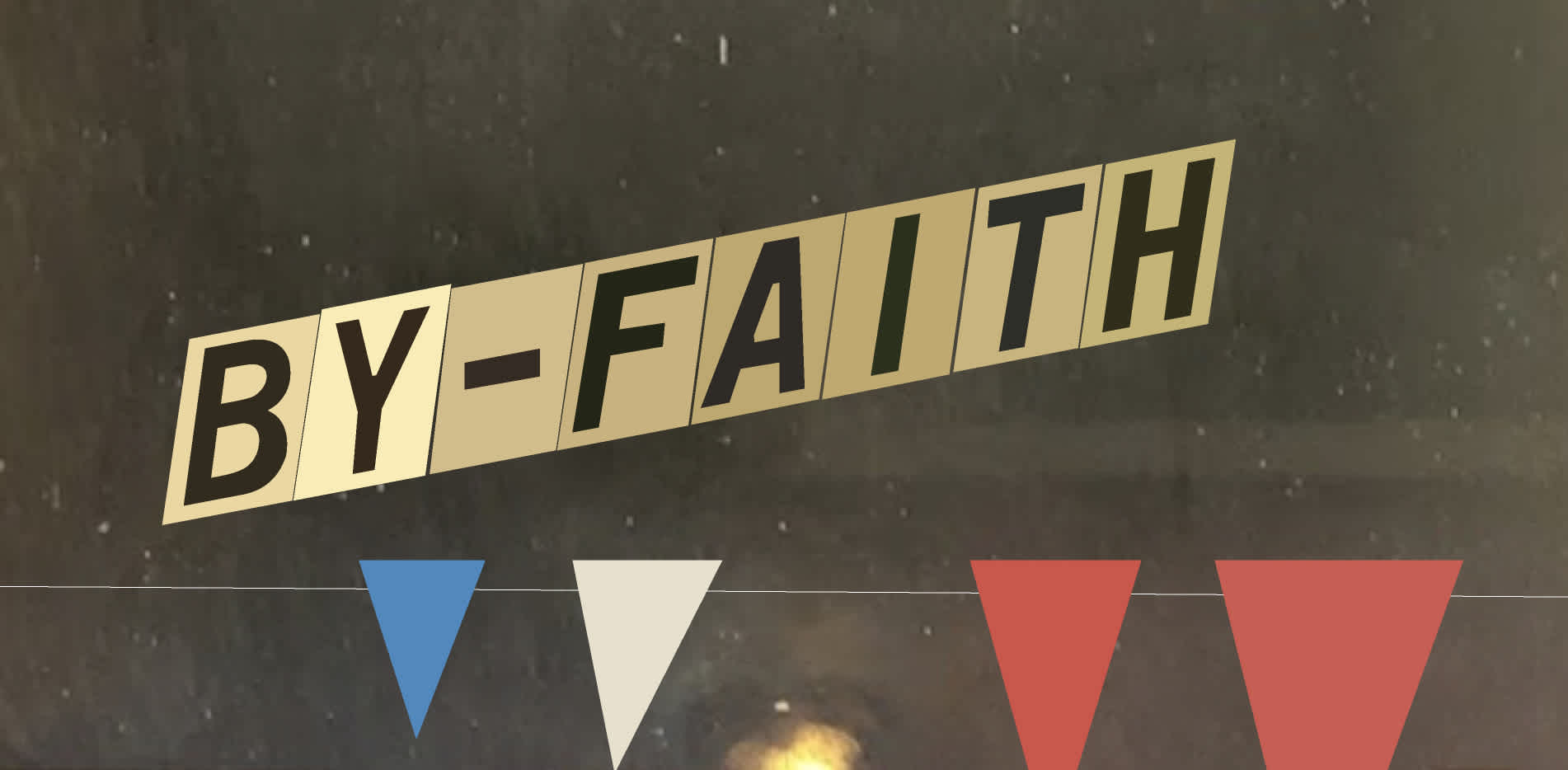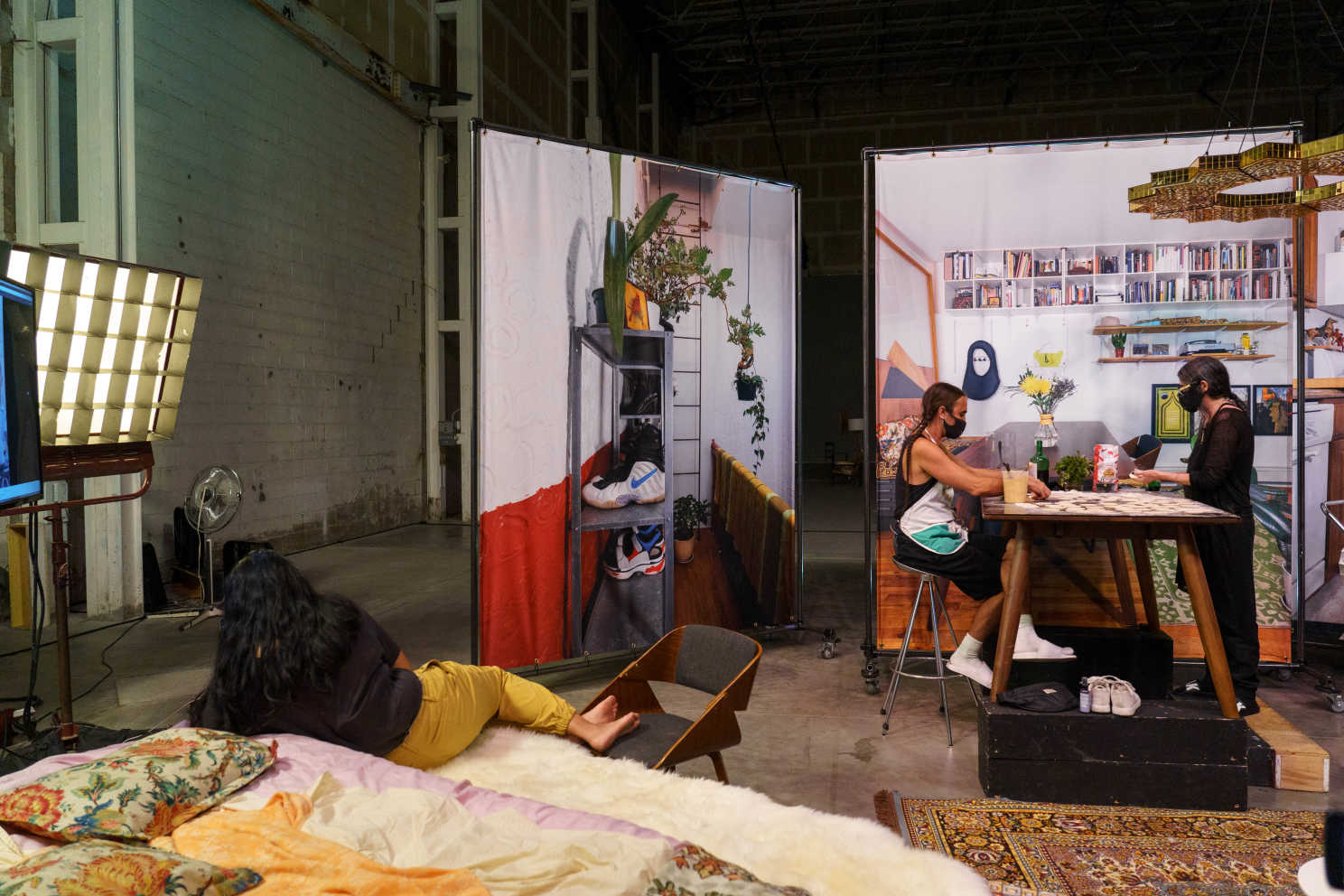
Credits:
By Kathy Cho, 2020–2021 Curatorial Fellow and Lumi Tan, Curator
December 9, 2020
Baseera Khan was in residence through The Kitchen at Queenslab from September 11–October 11, 2020, working on producing a pilot for their television show, By Faith. On October 8, Khan, Curator Lumi Tan, Director/Producer Ethan Weinstock, and Cinematographer Chris Wairegi were in conversation for a virtual wrap party. Excerpts from the wrap party conversation are highlighted below (with minor edits for style and clarity). Following that event, Curatorial Fellow Kathy Cho rounded out the conversation by posing additional interview questions about the collaborative processes, intentional care, and unique conditions that informed the creation of By Faith during the ongoing pandemic.
The pilot of By Faith will air after a post-production residency at the Wexner Center for the Arts in early 2021.


On Beginnings
Lumi Tan [LT]: The Queenslab space is an 8000 square foot warehouse space with forty-foot ceilings in Ridgewood, Queens.
When I invited you, Baseera, you had a few different ideas: there were raves, recording an album, a talk show. I know of your work in sculpture and installation, photography, performance. By Faith is all of these things and much, much more. It is a completely new direction for your work. How did this television pilot come out of this moment in your practice and your life?
Baseera Khan [BK]: I’m definitely a storyteller—give me a subject and I’ll run it into the ground. I think that a lot of ideas that I had with you, I was excited about, but I didn’t get the little chills on the back of my neck. I know I have it right when I receive that sensation. So I was really depressed about it. And then on top of that, there was COVID and everything. I was in bed, and I was watching a lot of TV, and I do watch a lot of TV—have watched a lot of TV ever since I was a child. At some point I was like, “what’s the thing that everyone in the world can relate to?” And I was like, “oh TV. OK, so how do I do this?” Then I watched a lot of really awful, “how to make TV” clips on YouTube and stuff.
Ethan and I have been friends for a really long time. I know that Ethan’s been doing production stuff, and we would always talk. He was there for me when I was “little sicky girl” in bed. And you just got invested in it, Ethan—you tell me. But, at some point it went from this kind of Proustian idea of being in bed and writing seven volumes of chatter from a fever to, “let me do this. How do I do this?” So I started creating mood boards. And luckily I was able to meet Chris. When Ethan and I reviewed the tapes and checked her out, we were like, “please, please let her like us.” And then we met and it was magic!
LT: Ethan and Chris, have you worked on a project like this before, or did you feel like this was a completely new direction for both of you?
Ethan Weinstock [EW]: Never. Never, ever before but hopefully many times again.
Chris Wairegi [CW]: I think it’s safe to say this is unlike anything I’ve ever participated in. But I was bred and broken by an experimental filmmaker in my very first film job. It was really spectacular to return to a magical place. I think the reason anyone falls in love with cinema is the limitlessness of it, not the limitations. I feel like everything Baseera brought to us was about breaking ideas, experimenting and playing with everything, making everything feel like a question, instead of assigning answers to our work. So everything was very collaborative and really fun.
While we were shooting, we’d go into everything with an idea about how it would work, and then everything would change. Someone would get a new idea, or something would be special, or we’d see a shadow someplace that would inspire a different take on something we planned. It just was really organic and collaborative and totally unique. A completely unique experience.
EW: Yeah, it was really amazing. Baseera and I talked about how the conception of almost all of their projects start from a place of limitless potential. They’re not a person who self edits in a way like, “oh, I could never do something like that. I don’t have the resources or I don’t have whatever.”
Baseera always starts with a place of magical thinking, then zeroes in as they go in this amazing way that’s like, “this is this part of reality that makes this work,” and “this is that part of reality that makes it work.” It was a really inspiring process to be with Baseera from basically the genesis of this version to completion. And we’re not even done yet. We haven’t even started post-production.
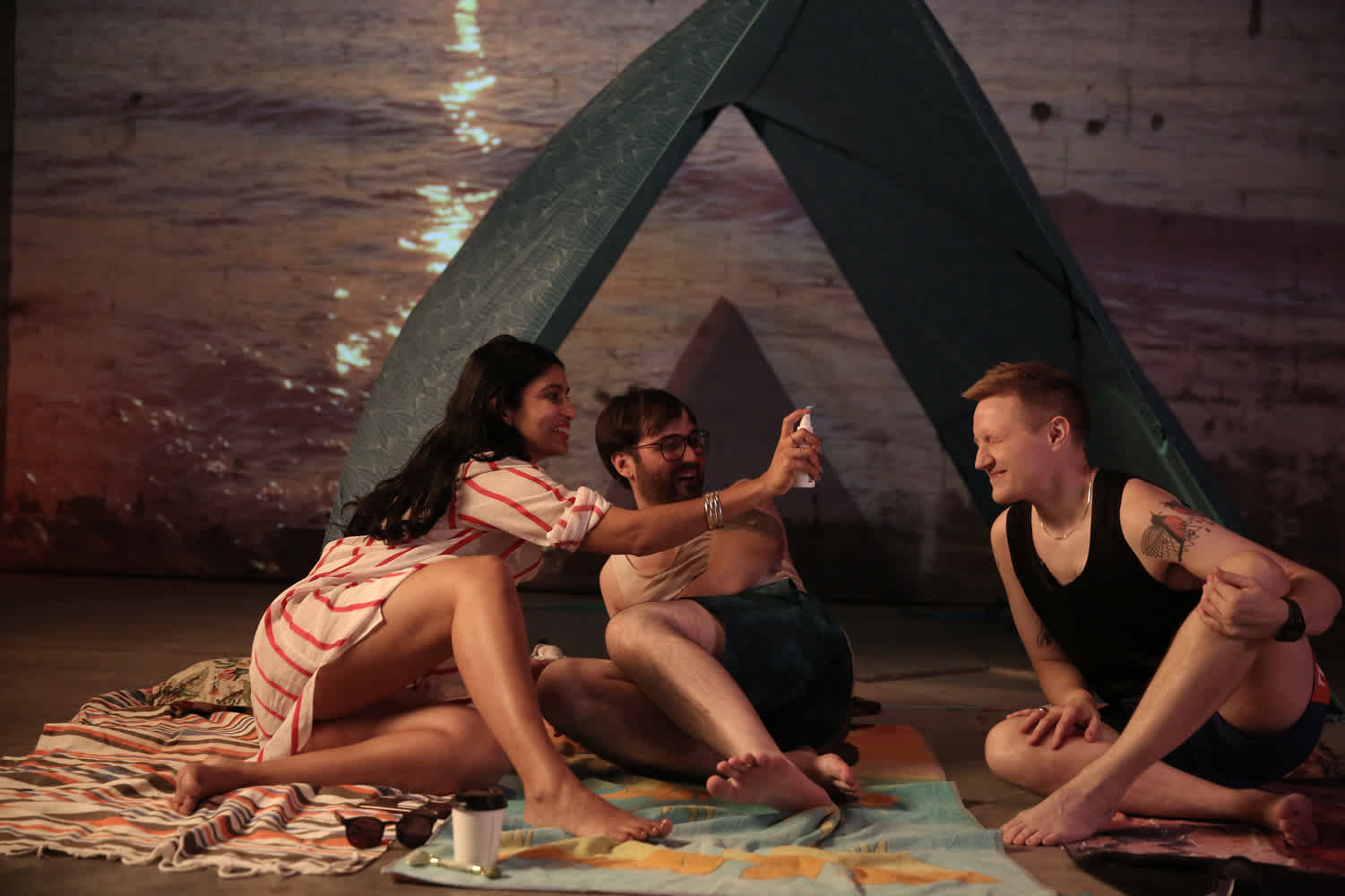
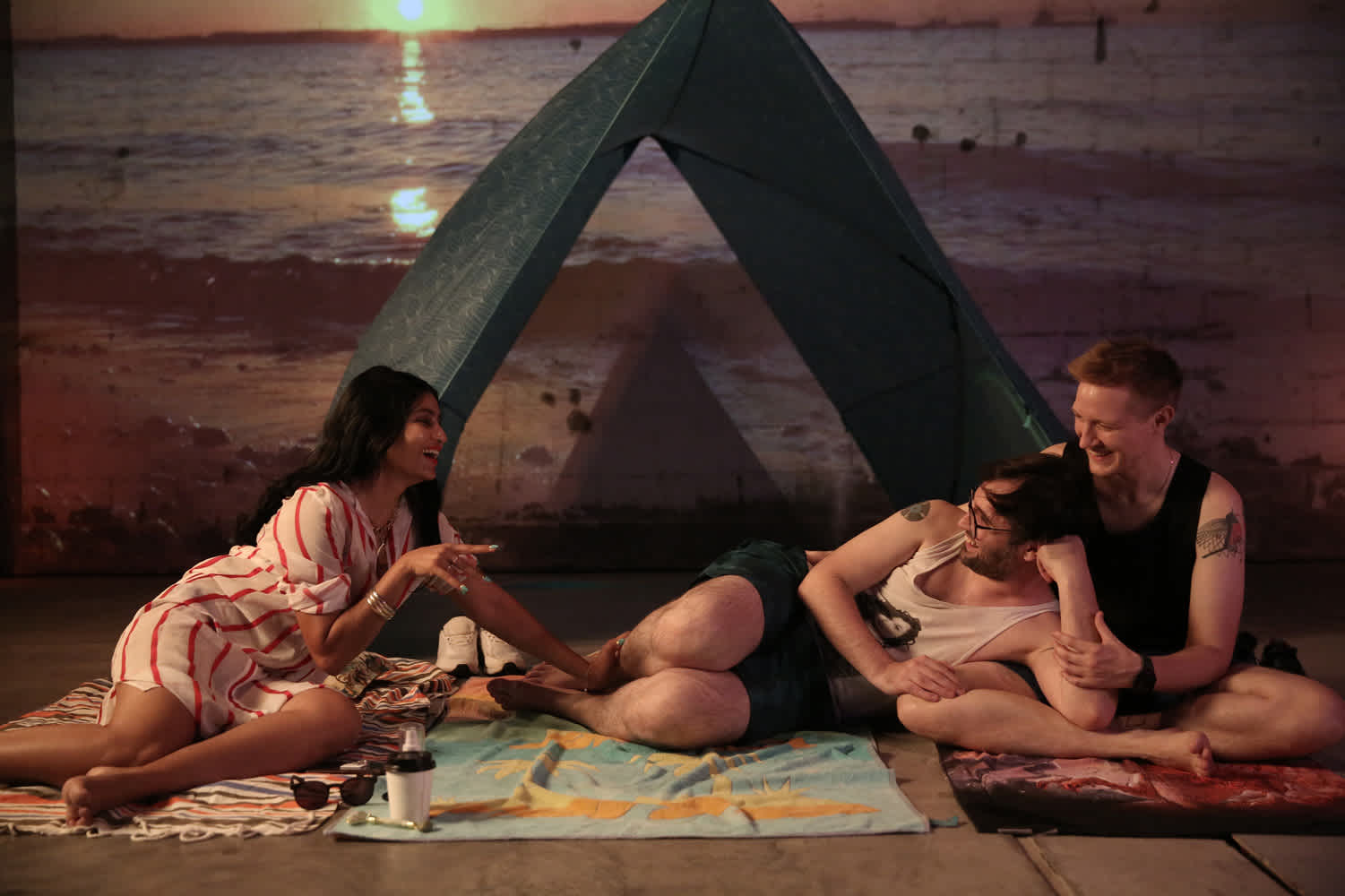
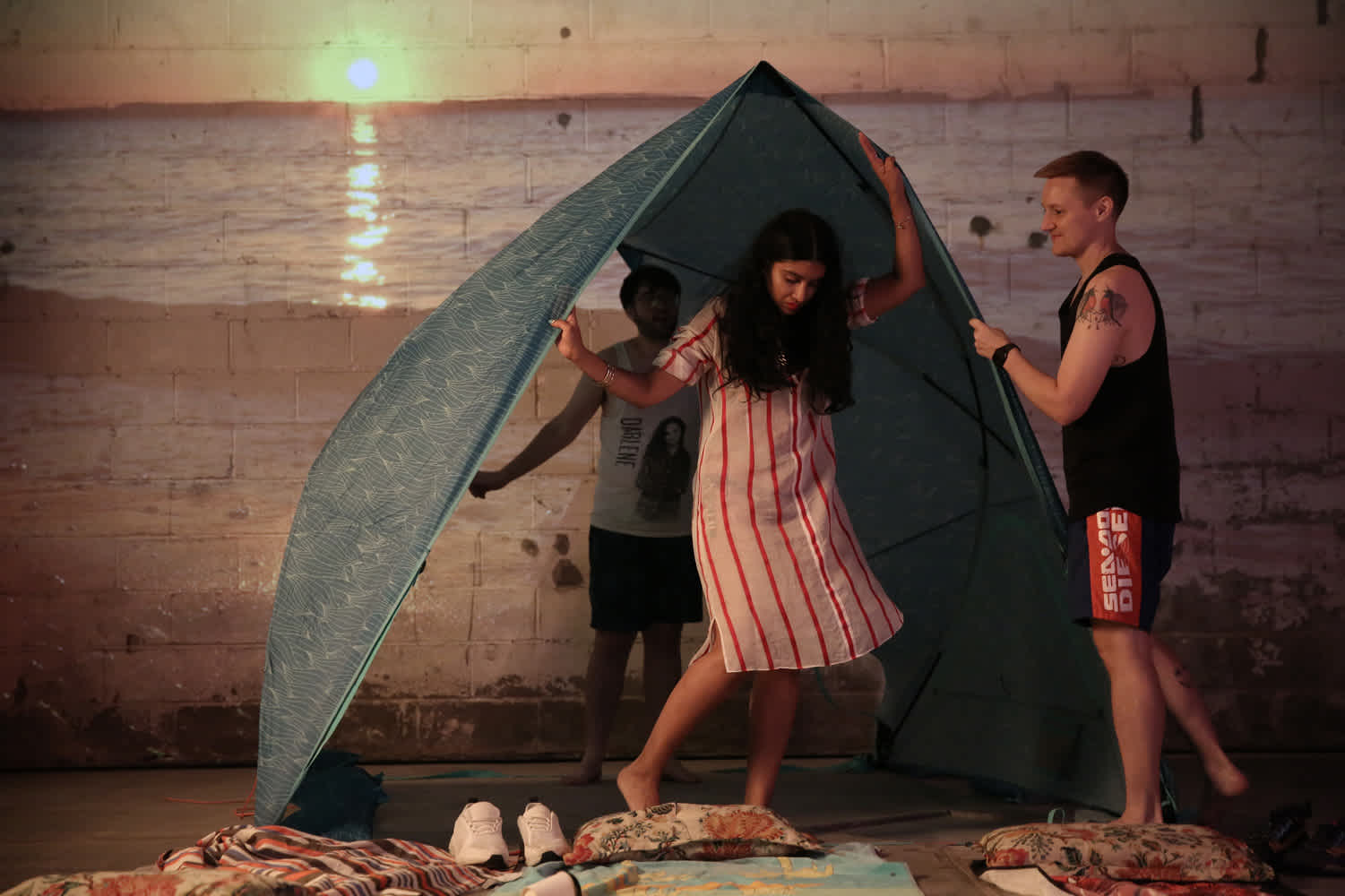
On Process
BK: The beach scene was a good example of just three people being really comfortable and allowing for each person to perform themselves. I’ve always had problems with sunglasses—there’s a little plastic thing that always pops out of it. So once I stepped on it, I knew that the plastic thing had completely become dysfunctional. I knew that adding that extra element would cause more chaos. Anyone who knows me knows me as somebody who could potentially be an agent of chaos. So that helped keep the scene going, like a very I Love Lucy slapstick moment.
CW: I think it’s a hurdle, making a space for everyone to feel comfortable, sometimes more than it was in how to direct and shoot it. Baseera had a philosophy that we maintained: it is supposed to feel clumsy because that’s how life is. And there should be room for improvisation, inclusivity, and for people to be who they are naturally. So if that means doing it more times to figure out exactly the words or the actions, you keep doing it. And the more you do, it feels natural. I think the beauty of the rehearsal was allowing everyone on camera to get acquainted with the space the way you would someone’s home. By the time we were filming in the space, everything had already fallen into place.
EW: Chris, what did you think of shooting that scene with Amy and Baseera? Because it was definitely very run and gun. We were trying to catch every angle that day. And it was only you operating the camera, which was crazy. If you don’t know, to have a single operator who is managing to nail every single angle—Chris is a rock star.
CW: It was great because I had the support of a fantastic team. We discussed this scene and decided we were going to play fluidly and shoot like it’s a documentary. So the whole time I’m thinking through where both cameras are, because we had two cameras, even if there’s only myself operating. I’m thinking through the actions of the scene, Amy and Baseera’s movements. I want to make sure I see some paintbrushes. I want to see hands, faces depending on the conversation. I want to pick up on the most important element, and also make sure the other shot is complementary so that they can give the editor something that matches.
We had a documentary approach for a very whimsical idea of something that exists in a dream space. The dream was starting to devolve and unfold with the beach scene being projected on a wall. So how do you honor something—how do you approach something from a documentary standpoint, but honor it in terms of a very artistic, creative, un-reality? That was a challenge throughout. The beauty of Amy and Baseera’s relationship is that it’s so natural. And the conversation is so natural that it is easy to play in the moment.
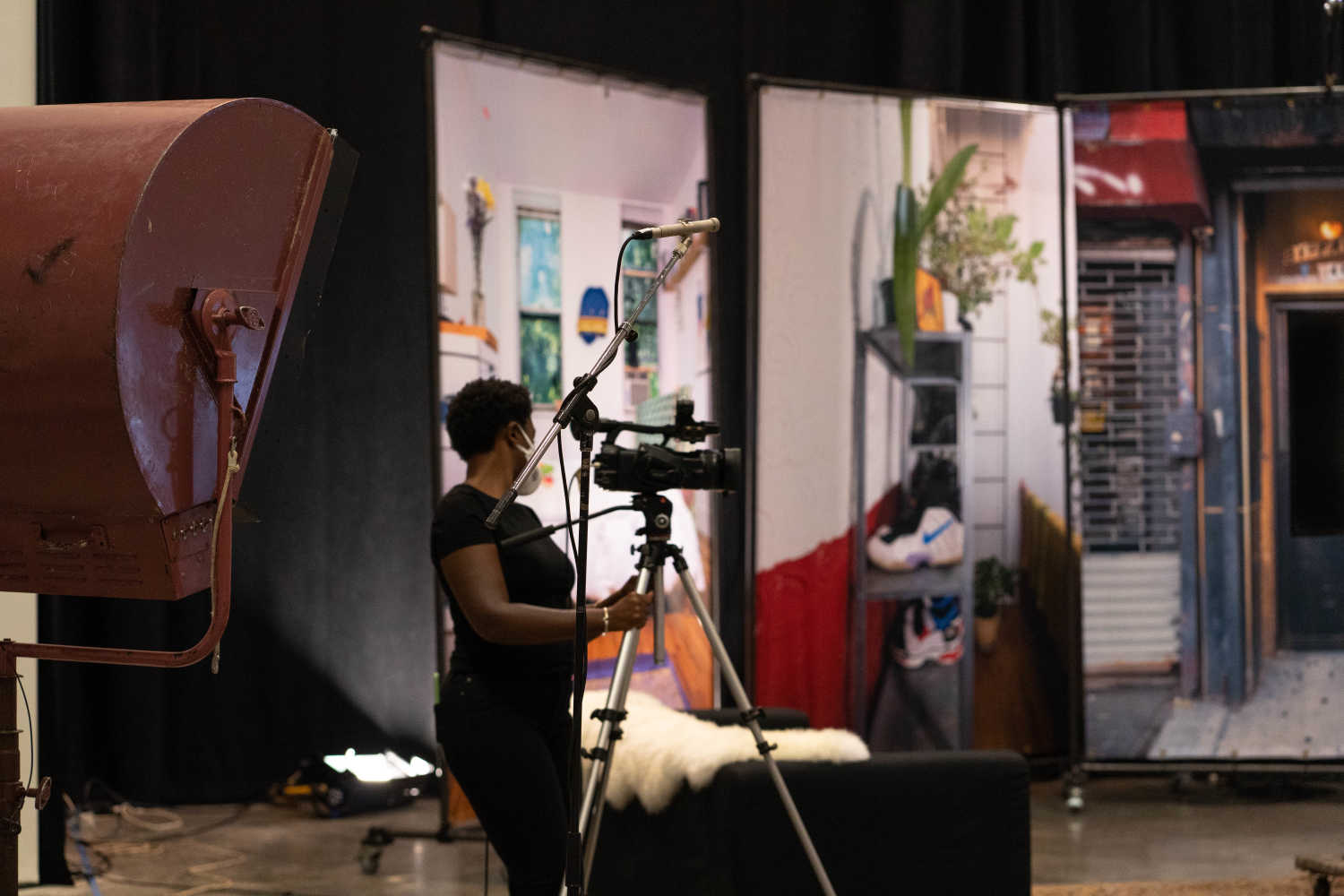
On Working During a Pandemic
LT: We wanted to address the practical parts of working together and just talk a little bit about the safety precautions so that it can be a resource. It has been a really incredible and emotional experience to work through this moment at The Kitchen, a small arts organization. You get to know people really well through this time.
Queenslab is an enormous space. We were able to work in it through the generosity of our collaborators there, Jim Hodges’s studio. And we were working in masks the entire time other than the shoots. I want to give a shout out to Mariana Catalina, who is our incredible stage manager and COVID supervisor.
BK: She was the shepherd of making sure we were all safe.
LT: Yes, making sure we had all our PPE and N95s when unmasked performers were shooting. Lots and lots of hand sanitizer.
EW: Those giant air filters.
LT: And air filters that drove Drew, our audio supervisor, crazy.
It’s a labor of love and we wanted to make sure that everyone was very comfortable. Communication is key in this situation. I don’t know if anyone else has anything to add to that.
EW: What really came through to me was the emotional experience that came with having to navigate COVID. Not just people’s level of comfort, but the feelings that came up because of it and being present for those. And also validating everyone’s feelings around fears, expectations, and the realities of, “OK, we have to switch gears. This isn’t going to work because safety is the most important thing.”
CW: We were always in conversation about the smartest way to do things. We never rushed our schedule. We had a nice cadence and we kept crew limited and made spaces for everyone. When people didn’t need to be on set, they weren’t on set, but they were always nearby and at hand since we had wireless communication. We would make sure the space was regularly ventilated. There was plenty of air. People had time to walk outside.
Talent would always be in masks right before rolling. I think we all were very receptive to the gamut of interaction. Some of our crew had COVID already. Some people have not. Some people were quarantined. Some of us have been on larger sets with crews. So I, for one, was very grateful to The Kitchen for facilitating all the logistics and always prioritizing the safety of the crew and cast.
LT: We’re all really grateful for each other through the process.
We have a question from the audience: “as you’re still working through this production, have any new seeds of inspiration for future projects come out of this process?” I would apply that to all three of you too.
BK: Yes, I learned something about myself and my ability through the process. And I know I had an amazing team with me that encouraged my intuition. I was really good at carrying out a narrative and performing in a way that was much more scripted than spontaneous. That’s really not something that I knew I could do, quite in the way in which we did. So it opens up possibilities with new projects. But in terms of the next year or two, I think I’m at a cap for the work and the projects that I will do.
CW: For me, it absolutely has inspired me in thinking differently about everything. I’m a lush, so I’m going to keep making all the great things I can make. It was freeing. Baseera and I had a conversation early on in terms of—Ethan and I serve a role more like technicians to the project, and Baseera being the more fluid creative side. Then Ethan and I worked to translate Baseera’s vision to a medium that he and I are familiar with.
With that being said, Baseera broke every rule of filmmaking constantly. We were constantly reinventing our plans and ideas we had around it. So I think it also challenged us and reminded us not to feel married to ideas. Filmmakers are familiar with the saying, “kill your darlings.” That’s basically, you go into any situation and recognize that if something is not working you change it, and you should always lean into being creative. If there’s a better way to do something, you do it. So in terms of how we work together as a team, how we thought of making the piece creatively and just being as free as we could with the resources at hand. I want to make a hundred more things like this.
EW: Same, 100%. I walked away from this being like, “wow, this is possible.” You can take a crew of fifteen people and a budget that’s nowhere, maybe one percent of what a studio spends on a regular TV pilot. And you can make something truly magical, and you can do it over and over and over again. And that’s what that was—is what’s inspiring me. I feel like I want to go out and do like eight more of these.
CW: And we’re not done with it yet. I mean, I think about it all the time.
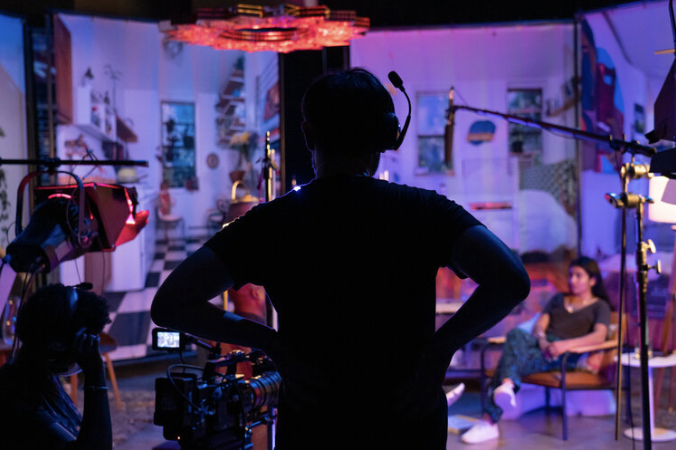
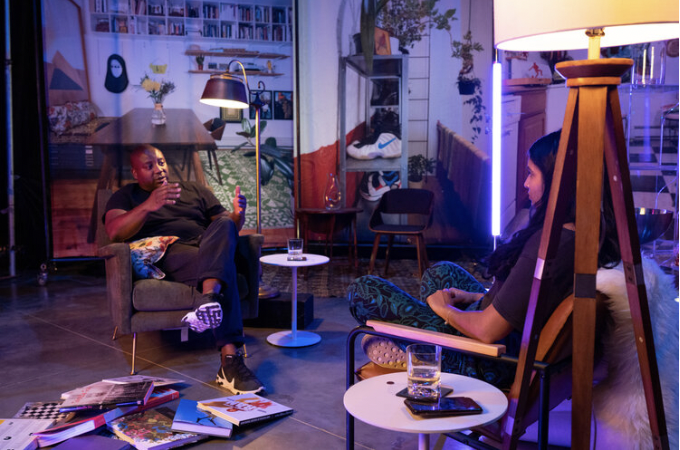
On Speculative Futures
Kathy Cho [KC]: How, if at all, have your methods of collaboration changed during this period? If there are changes, what’s one main thing you plan on continuing to practice when working with others?
BK: I love the lessons you learn when working in close proximity with others. It’s also important to really know your own perspective and stay true to what you need and what feels necessary. Collaboration is within everything, as it turns out. Even an artist who thinks the work they do is solitary could take a step back to find a village of people who have been there the whole time.
CW: This year has taught me to do more with less: less people, less time, less funds. Filmmaking feels more like a meditation: you have to be more intentional, more methodical—the need to always be two steps ahead reminds me of shooting celluloid, really. I am thankful to be more grounded in the moment now and take more time to accomplish something the entire team is proud of. We knew the circumstances required a lot of conversation and expression of each person’s comforts and wishes, and I hope it’s an exercise we apply well into the future. It’s special to learn with people and embark on new works at a time like this.
EW: Film is a medium of collaboration. It’s about collectively creating a dream state and sharing with the viewer in a way that invites them to identify that dream as their own. I think it was the practice most ready to adapt to making art in COVID, but, at the same time, it’s a community and an industry that doesn’t like to change its tried-and-true methods.
Working with Baseera, who came in without preconceived notions of how a film needs to get made, plus working with a talented filmmaker like Chris, just made inventing new methods and concepts feel like it was second nature. THIS NEVER HAPPENS! You don’t walk into a set and just immediately gel with everyone like you’ve been working together for decades. It’s a real testament to the immense creativity and talent that I had the pleasure to work with every day during Baseera’s residency. I’m taking all that knowledge and good energy onto every project I do after this.
LT: With each project, I learn from artists and their collaborators on the myriad ways to work together—in this case it was learning from film crews and how they might be similar to or different from theater or exhibition productions, and all the roles necessary to realize shared visions. All of that becomes integrated into my curatorial work moving forward.
KC: How did Baseera’s (and eventually everyone’s) experimental process for filmmaking allow for speculative futures?
BK: Hmm—well rethinking production of moving images is definitely a speculative future. We are rethinking traditions that are deeply rooted in old systems. With the level of technology and able bodies who are quick on their feet on our team, we enabled each other to produce By Faith with a skeleton crew. It takes courage to allow for other knowledges to influence your truths in the making process, and we were lucky to have that kind of symbiosis.
CW: Baseera’s process, I think, reminded us all as viewers and collaborators of the beauty in the months of solitude and seclusion that really was and is there with us. It’s easy to belabor the very real horror that we as New Yorkers survived, but it’s also important to celebrate our life, resilience, and all the small, weird, and beautiful details of these lives we lead. Baseera does not shy away from awkward, troubling, or fearful realities, and in that they create room for all of us to sift through our emotional wreckage.
I remember sitting in our concrete studio on a chilly day, filming a scene that takes place at the beach in the summertime. You looked around the studio and the whole crew seemed warmed by it, a memory that wasn’t even our own, but that we all shared in. There was an element in re-creating the memory that was communal and bittersweet and provided I think a sense of closure for us all.
EW: I think that Baseera’s work already operates in that space of thinking about futures (and pasts!) that exist beyond the confines of what seems probable or likely. I remember seeing Snakeskin and thinking about those giant resin objects they made that looked like psychedelic ruins of an ancient city. Same with Braidrage, turning their own body into a wall that they had to surmount. By Faith was just about bringing those motifs into a different medium and giving them the framing device of the apartment they live in. I remember the first day I walked on to the stage after the flats were installed and feeling like I was Alice—that I had just stepped through the looking glass.
LT: Thinking of the arc of emotionally processing this pandemic, it’s been incredible how artists like Baseera have helped me understand what is really possible in a world that’s only showing you limitations, constantly telling you “no.” It’s Baseera’s idea of not only having a seat at the table, but bringing your own table, writ large. They see through barriers, and help us cross them as well.
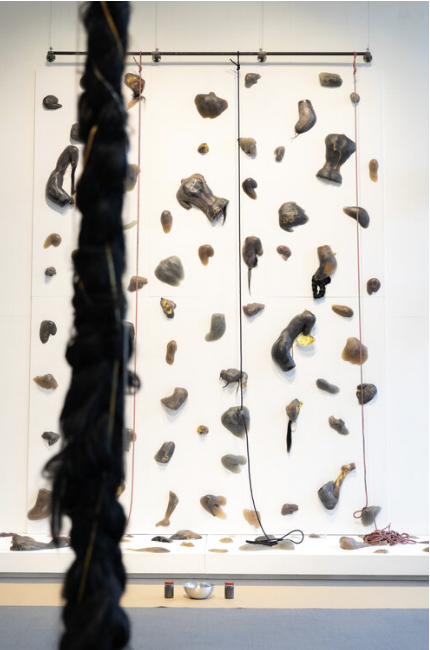
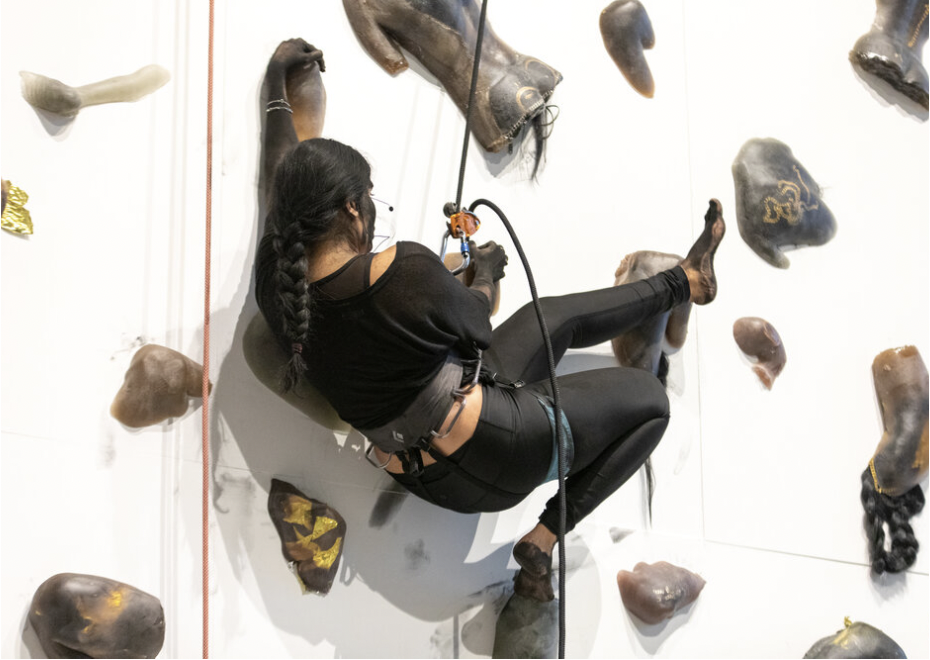
Images: 1) Left: Baseera Khan, T De Long, and Lia Gangitano in Baseera Khan, By Faith, September 13, 2020. Rehearsal view at Queenslab. Photo by Ariana Sarwari. Right: Lia Gangitano in Baseera Khan, By Faith, September 13, 2020. Rehearsal view at Queenslab. Photo by Ariana Sarwari. 2) Left: Ethan Weinstock, Baseera Khan and Logan Jardine in Baseera Khan, By Faith, September 26, 2020. Performance view at Queenslab. Photo ©2020 Paula Court. Top Right: Baseera Khan, Ethan Weinstock, and Logan Jardine in Baseera Khan, By Faith, September 26, 2020. Performance view at Queenslab. Photo ©2020 Paula Court. Bottom Right: Baseera Khan, Ethan Weinstock, and Logan Jardine in Baseera Khan, By Faith, September 26, 2020. Performance view at Queenslab. Photo ©2020 Paula Court. 3) Ethan Weinstock and Baseera Khan in Baseera Khan, By Faith, September 11, 2020. Set view at Queenslab. Photo by Ariana Sarwari. 4) Left: Baseera Khan, By Faith, September 27, 2020. Set view at Queenslab. Photo by Ariana Sarwari. Right: Rico Gatson and Baseera Khan in Baseera Khan, By Faith, September 27, 2020. Rehearsal view at Queenslab. Photo by Ariana Sarwari. 5) Left: Baseera Khan, Braidrage, 2019. Installation view at the University of Albany. Photo by Ariana Sarwari. Right: Baseera Khan, Braidrage, 2019. Performance view at the University of Albany. Photo by Ariana Sarwari.
